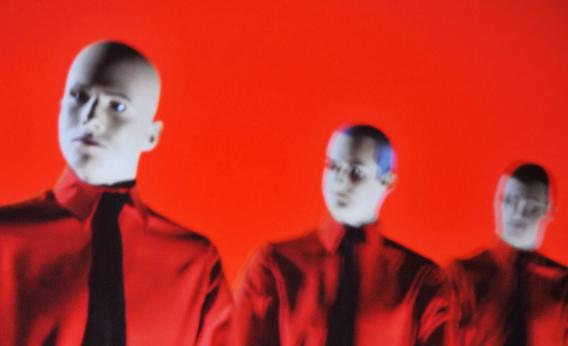There was no more coveted piece of New York City real estate on Tuesday night than standing room in the Museum of Modern Art’s Marron Atrium. And so it shall be for six more evenings as Kraftwerk, the German electronic outfit from the 1970s, plays to a scant crowd of about 450 lucky souls. That this quartet, which includes just one of its original members, can command a showcase like the MOMA - and sell out in a drumbeat - provides a useful lesson in technology’s risk of obsolescence.
It would be easy to dismiss Kraftwerk as a relic from the dawn of the digital age, and its ardent fans a weird cult in turtleneck sweaters and 3D glasses. But the eight-night retrospective of the band helmed by Ralf Hutter provides surprising insight into why some innovations fade and others flourish. Ultimately, success in technology - as in art - is derived more from the expression of big ideas than a mastering of its circuitry.
Kraftwerk is best known for harnessing new gadgets, primarily synthesizers like the Minimoog, to create industrial rhythms and electronic drum beats that broke new ground in pop music. Its sounds have been copied, built upon and sampled by artists from Afrika Bambaataa to Pink Floyd to Jay-Z. Today’s auto-tuned pop stars owe a direct debt to the musical sequencing that Hutter and his former partner Florian Schneider pioneered at their Kling Klang Studios in Düsseldorf four decades ago.
Yet funky sounds alone fail to explain how the group’s four musicians - looking more like engineers in Tron-era spandex suits - can rivet the attention of New York’s cultural elite for an entire week. That speaks more to the larger concepts embraced by Kraftwerk, chiefly the power of technology - specifically computing, transportation and communications - to transform human relationships; and, particularly in the German context, to erase the scars of a dark past with visions of a unified, harmonious Europe.
Take Tuesday’s performance of the 1974 breakthrough “Autobahn.” The song, with its signature electronically-modified vocals, “Wir fahr’n fahr’n fahr’n auf der Autobahn,” against a rhythm of padded drum beats, is sonically unforgettable. But so, too, is the song’s message, enhanced at the MOMA by 3D screens looming behind the stage, of a peaceful Europe where new highways cut through green fields and the edifices of a modern industrial complex compete with church spires in the middle distance. Like the space-agey sounds emanating from Kraftwerk’s instruments of the era, the limited torque of a 1973 Mercedes diesel sedan might seem obsolete in today’s world. Yet the freedom of the open road remains an eternal longing.
Similarly, the electronic arrangements of the 1977 composition “Trans Europe Express” may sound old-fashioned to 2012 ears. But the song’s message, that modern transportation (in this case high-speed rail) offers the possibility of stitching together a continent that just a generation before was at war, is timeless and transcends the music.
Kraftwerk’s biggest ideas, of course, stem from the all-pervasiveness of digital culture in everyday life, best expressed in “Computer World,” from 1981. While it may sound quaint in the iPhone era, the song suggested that computing itself would change how man viewed “business, numbers, money, people,” and reshape “crime, travel, communication, entertainment.” Kraftwerk couldn’t have been more right.
Indeed, it’s a useful reminder to those innovators, such as the hot tech companies of the moment, who may regard themselves as cutting edge in the way many once saw Kraftwerk in the realm of music. Obsolescence is always just around the corner. Take the cellphone business, where Palm begat BlackBerry, which begat Nokia, which begat Apple. Or consider electronic games, where it’s possible to draw a distinct line from Atari to Zynga, with a cemetery full of defunct champions in between.
The only constant is that today’s avant-garde technology will be tomorrow’s also-ran. Like Kraftwerk’s lunar sounds, inventive products and companies will come and go - and their makers diminish - but the fundamental urge to communicate, play and connect will never die. The success or failure of their creators will depend on an ability to adapt and capitalize on larger human impulses. The improbable revelation from Kraftwerk’s continued relevance is that technology itself is merely a small part of the equation.
Read more at Reuters Breakingviews.
